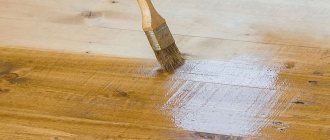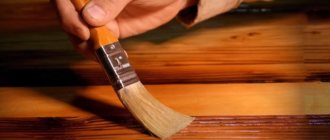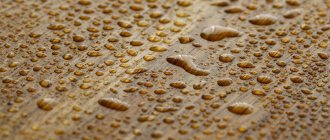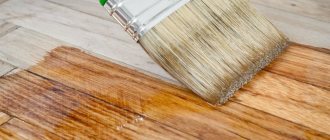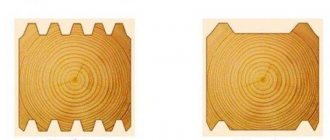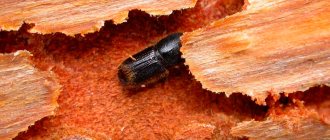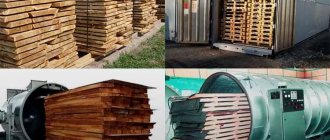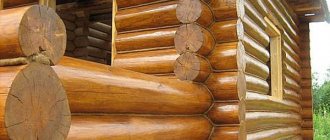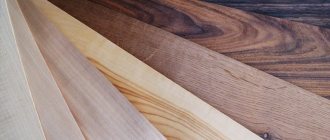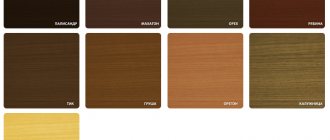In wooden construction, everything needs to be done on time. Unfortunately, many become convinced of the truth of this truth too late, noticing traces of the work of wood-boring beetles on the beams or looking at the embers of a burnt house.
Wood is a delicate material. Despite its high strength, it is afraid of fire and dampness. Insects that feed on cellulose also pose a serious danger to it.
Without the use of special protection, not a single wooden house can resist fire, and its beautiful golden facade will become gray and dull in a couple of years.
How can you protect wood from aggressive factors? What products are best to buy for this?
How is fire bioprotection applied correctly and is it hazardous to health? We will answer all these questions in our article.
What is fire bioprotection and how does it work?
Despite all the achievements of science, a means has not yet been invented that 100% protects wood from fire and biological destruction. Any fire-bioprotection of wood only makes it more difficult to ignite and slows down the development of microorganisms.
Since the main danger to a wooden building is fire, manufacturers focus on the effectiveness of fire retardants - substances that make it difficult for wood to ignite. It is their properties that we will consider first.
There are three main physical processes on which fire protection is based:
- melting of substances that make up fire retardants (silicon, boric or phosphoric acid salts);
- decomposition of substances that release gases that do not support combustion (sulfur dioxide and ammonia);
- swelling of the protective shell, preventing contact of fire with the surface of the wood (organophosphorus compounds).
Most fire retardant compounds, in addition to the fire retardant component, contain an antiseptic - a substance that prevents biodestruction of wood (mold, rot, blue stain, wood-boring beetles). The mixture of these two substances is called “fire and bioprotection of wood”.
Fire retardants
All compositions that ensure the fire-resistant qualities of wood can be divided into the following groups:
- Impregnations. They are supplied ready-made or as a mixture of salts, which requires preliminary preparation. When heated, such compounds release gas, which helps lower the temperature. Due to this, the reaction between flammable substances slows down and their ignition is delayed;
- Fireproof paints. They contain fire retardant salts. During the heating process, the paint layer begins to bubble, forming a layer that provides insulation from high temperatures;
- Fireproof varnishes. They are based on urea-formaldehyde and similar resins. As the varnish heats up, it becomes covered with small bubbles. The thin layer of bubble-forming resin melts and chars. As a result, a porous layer of approximately 7 mm is formed, which helps protect the wood from fire.
Features of wood processing with protective compounds:
Types of fire-bioprotective compounds
To correctly answer the question of how to choose fire protection for wood, you need to know its properties and application features.
There are two groups of protective substances on the market:
- Fire retardant impregnations;
- Fire retardant coatings (pastes, enamels, varnishes and coatings).
The main difference between them is the aesthetic qualities of the treated surface. Impregnations do not change the smell and texture of wood. Coatings, on the contrary, worsen the appearance of the treated surface and have an unpleasant odor. Therefore, they are used to process load-bearing wooden structures that are hidden by finishing.
In addition, all fire-bioprotective substances are divided into organically soluble and water-soluble. The first type of protection requires the use of flammable and toxic solvents, which significantly limits the scope of their use.
Water-soluble fire-bioprotection is safer and more versatile, which is why it is most often used in wooden housing construction.
According to the chemical formula, it is divided into two categories:
- Saline;
- Non-salt.
Non-salt fire protection for wood appeared quite a long time ago (80s of the last century). Despite its advanced age, it is actively used in practice today. The basis of such impregnations are salts of boric, carbonic or phosphoric acids.
The main advantage of salt protection is low cost. It has more disadvantages: short shelf life (3 years), low degree of protection, high consumption, impossibility of painting and easy washing out with water. Therefore, salt compositions are mainly used for treating wood indoors.
Non-salt fire protection (based on organophosphorus substances) is more beneficial. It does not spoil the appearance of wood, binds securely to its fibers, and has high fire and bioprotection properties. Wood treated with this impregnation can be painted and varnished. Non-salt treatment retains its properties for 10-15 years. It is non-toxic and safe for health.
TOP 8 manufacturers
Products are manufactured by several companies, so many consumers have difficulty choosing high-quality and effective products. We have prepared for consideration 8 brands that are respected among builders and have proven themselves on the positive side.
Tikkurila Tex Universal Fire and bioprotection
Products from Finnish manufacturers with high biocidal and fire retardant properties. After application, the composition provides:
- second category of fire protection;
- protection of wooden elements from blue staining, rot and mold;
- prevents damage by wood-boring beetles.
The composition does not contain toxic components, has no chemical odor, retains its texture and decorative properties.
Impregnation is applied with a roller or brush; work is carried out only at positive temperatures not lower than +5 0C . After application it gives the surface a pinkish-red tint.
Phenylax
These are domestic products designed to protect wooden buildings and structures for any purpose.
- penetrates deep into the fiber structure;
- increases the fire resistance of the material;
- prevents the occurrence of biological contamination.
Organic solvents are not used here, therefore, there is no pronounced chemical smell. It is recommended to carry out treatment in the temperature range: +5… +40 0С , after application the base acquires a mustard tint.
Despite a lot of positive qualities, Phenylax lasts no more than 4 years , and is not suitable for protecting surfaces exposed to precipitation.
Olympus
These products are released onto the Russian market. The company has been producing protective compounds since 1992 ; currently, the Olympus includes two items:
- Fire protection 1 – protection from open fire for 7 years .
- Fire protection 2 – protection from open fire for 5 years .
In both cases, the antiseptic properties are maintained for 10 years .
Fire protection 1 creates a reddish layer on the surface that tints the base. Products of the second group are transparent or pronounced red in color. The compositions are suitable for interior and exterior use.
| Comparison criterion/Product name | Fire protection group 1 | Fire protection group 2 |
| Purpose | clear from the name of the composition | |
| Average fire protection period | up to 7 years | up to 5 years |
| Average biosecurity period | up to 10 years | |
| Fire retardant efficiency group | I | II |
| Surface treatment control | translucent composition with a red tint, tints wood | two options: colorless and with a red tint |
| Consumption, ml/sq. meter | 550 | 500 |
| Packing, l | 10, 20 | 5, 10 |
Senezh
Under this trademark, a wood impregnation developed by the Senezh-Preparaty . The company has its own research base and chemical laboratory, which allows it to produce high-quality products.
- reliably protects wooden surfaces from biological influences;
- makes the material fireproof;
- prevents the spread of open fire.
Fire retardant properties last for 3-5 years , bioprotection up to 20 years . Depending on the category, impregnation may form a transparent film or change the color of the surface.
| Comparison criterion/Product name | SENEZH OGNEBIO | SENEZH OGNEBIO PROF |
| Purpose | for protection against fire, flame spread | for protection against combustion, ignition, flame spread |
| for protection against rot, mold, blue stains and wood-boring insects | ||
| Average fire protection period | 3 years | 5 years |
| Average biosecurity period | 20 years | |
| Fire retardant efficiency group | II | I or II |
| Surface treatment control | no (transparent composition) | yes (colored composition) |
| Consumption, g/sq. meter | 600 (II gr.) | 600 (I gr.) or 300 (II gr.) |
| Packaging, kg | 5, 10, 65, 70 | 5, 25, 75, 80 |
Neomid
The products are manufactured in four categories and provide class 1-2 fire protection , which lasts for 7 years . Bioprotective properties are maintained for 10 years from the date of application.
The impregnation forms a durable fire-retardant film, which swells upon contact with fire, forming a kind of protective screen.
After treatment, the surface becomes reddish in color or remains unchanged, depending on the product category. The composition is suitable for any wooden surfaces for which no further mechanical treatment is expected.
| Comparison criterion/Product name | NEOMID 450 (impregnation) | NEOMID 450-1 (impregnation) | NEOMID 001 SuperProff (impregnation) | NEOMID 040 Professional (paint) |
| Purpose | to protect wooden structures from ignition and flame spread | Provides protection against ignition, burning and flame propagation | ||
| bioprotection: against mold, rot, insect damage | ||||
| Average fire protection period | up to 7 years | |||
| Average biosecurity period | up to 10 years | |||
| Fire retardant efficiency group | II | I or II | I | |
| Surface treatment control | No | Red color | No | matte finish, tinted |
| Consumption, g/sq. meter | 400 | 250 (I gr.) or 150 (II gr.) | 600 (I gr.) or 500 (II gr.) | 250 |
| Packaging, kg | 5, 10, 20, 30, 200 | 5, 10, 30, 200 | 1, 5, 30 | 25, 60, 150 |
Pirilax
Produced by Izhevsk production, it is presented on the market in six variations. Purpose: protection of wooden structures and decorative elements from fire and damage by fungal spores.
Depending on the type, Pirilax is used for interior and exterior work, suitable for use in normal and severe conditions.
The compositions of this manufacturer have the longest service life and can retain their protective properties for up to 30 years .
| Comparison criterion | Pirilax (for external and internal work) | OZONE-007 (for interior work) | MIG-09 (for interior work) | |||||
| Lux | Classic | Terma | Prime | |||||
| Purpose | from fire and flame spread, from mold and insects | from fire, mold and insects | from fire and flame spread in the attic and on rafter systems, from mold and insects | |||||
| for harsh operating conditions | for normal operating conditions | for baths and saunas | for normal operating conditions | for treating attic spaces and rafter systems | ||||
| Average fire protection period | outside: up to 5 years; inside: up to 16 years | outside: up to 5 years; inside: up to 16 years; inside baths: up to 6 years | outside: up to 2 years; inside: up to 5 years | 5-30 years indoors depending on conditions | inside unheated rooms: up to 12 years | |||
| Average biosecurity period | outside: up to 10 years; inside: up to 25 years | outside: up to 7.5 years; inside: up to 20 years | outside: up to 7.5 years; inside: up to 20 years; inside baths: up to 6 years | outside: up to 2 years; inside: up to 7 years | not specified | |||
| Fire retardant efficiency group | I or II | II | I or II | |||||
| Surface treatment control | Tints with amber color | No | No | no, but with high consumption it can turn yellow | ||||
| Consumption, g/sq. meter | 280 (I gr.) or 180 (II gr.) | 200 | concentrate: 103 (I gr.) or 69 (II gr.) | dry concentrate: 100 (I gr.) or 50 (II gr.) | ||||
| Packaging, kg | 1, 3.3, 10.5, 24, 50 | 1.1, 3.5, 11, 24, 50 | 1.1, 3.5, 11, 26, 50 | 1, 3.2, 10, 22, 46 | 5, 16, 48, 65 | 25 | ||
Woodmaster, Pyrex
These varieties are produced. The solutions are characterized by high fire-resistant and bioprotective properties, but they differ somewhat in technical terms:
- Woodmaster – provides protection for up to 5 years , does not change the surface texture, makes the wood resistant to biological damage for 4 years .
- Pyrex - retains protective properties for 6-10 years for interior and exterior use, respectively. After application, it can decorate the surface, giving it a pink or dark golden hue.
Depending on these features, the cost of the material differs - Pyrex will cost more.
| Comparison criterion/Product name | WOODMASTER | ||
| CORD | KSD | PHENYLAX | |
| Purpose | transforms wood into a highly flammable material with protection against biological damage | transforms wood into a highly flammable material with two-level protection against biological damage, can be used to impregnate fabrics | transforms wood into a fire-resistant material, provides bioprotection under normal operating conditions |
| Average fire protection period | up to 2 years | 5 years | 3 years (I gr.), 4 years (II gr.) |
| Average biosecurity period | up to 4 years | ||
| Fire retardant efficiency group | II | I or II | |
| Surface treatment control | no (transparent composition) | yes (colored composition) | |
| Consumption, g/sq. meter | 600 (II gr.) | 600 (I gr.) or 300 (II gr.) | 500 (I gr.) or 300 (II gr.) |
| Packaging, kg | 5, 10, 65, 70 | 5, 25, 75, 80 | 6, 11, 25, 75, 220 |
OGNEBIO (PROSEPT)
Universal protection, suitable for treating internal and external surfaces. In direct contact with fire, the active components release a non-flammable gas that prevents the spread of open fire.
The composition does not change the texture of the base and is suitable for subsequent gluing or painting. Impregnation prevents the appearance of fungal spores, mold and blue stains.
Efficiency of fire bioprotection
Here we come to the most important thing, for which, in fact, protective compounds are purchased. Before you take your money to the cashier, pay attention to the protective effectiveness group indicated on the product label. It won’t be difficult to figure it out, since there are only 2 groups that characterize the impregnation’s resistance to fire.
If the label of the composition indicates protection group 2, this means that after treatment the wood becomes difficult to ignite. If you need to give wood the properties of fire resistance (higher resistance to open flame), then buy preparations of group 1 fire-retardant efficiency. For reference, we add that only such impregnations are allowed by fire regulations for processing wood in residential buildings.
It is also useful to know that by changing the number of layers of impregnation, you can easily vary the degree of its protection. For example, by making 6 “passes” with weaker fire protection of group 2, we will obtain the fire resistance of a wooden surface at the level of group 1. And vice versa, having impregnated the wood not twice, but once with stronger protection, we obtain group 2 fire resistance of the material. Be sure to take this fact into account so that the treatment of wood with fire protection gives the desired effect.
Benefits after wood treatment.
Wood preservative applied to the wood ensures that the wood does not rot. The requirements for different wooden objects differ from each other - be it furniture, building materials or paper. When it comes to building material, it is necessary to treat it with a fire retardant or use wood antiseptics.
Material on the topic: Comparison of chipboard and MDF.
When treated with antiseptics, a wooden house will last much longer.
- Protection from insects. As a natural material, wood is likely to become a favorite breeding ground for insects. The actions of insects lead to the destruction of the structure, and there is a high probability that insects begin to breed in the wooden environment. In this case, impregnation for external use is necessary.
- Allergy protection. If wood is exposed to moisture, it provides a good environment for mold. Mold causes fungal growth, which causes wood to deteriorate. Spores spread into the air, which is harmful to human health and contributes to people becoming allergic and more susceptible to various infections. In this case, the use of antiseptics against mold is simply necessary.
- Bioprotection for wood prevents the growth of fungi. Which decompose the wood from the inside and also destroy wood cellulose.
- Once the wood is treated with antiseptics, it creates a barrier to insects and mold and will remain in good condition and look good for a long time even after several decades.
- The structure will maintain heat. When wood is affected by insects or mold, it loses its insulating properties. But if it is treated with fire-bioprotection, it retains heat inside for a long period of time.
- Wood material tends to contract and expand due to temperature fluctuations, especially in baths and saunas. As a result, the wood changes its color and also cracks easily and hence deteriorates. To prevent this process, it is recommended to use non-washable fire protection.
- Wood treated with preservatives lasts much longer, so you can enjoy your structure for a long time without having to replace elements after several decades. The best antiseptic is considered to be a liquid solution that penetrates deeply into the structure of the material. But the choice is always towards fire protection, since this is a remedy not only against rot, but also against fire.
READ Impregnation against moisture and rot: how to extend the life of wood
Industrial compositions for wood.
Consumption, penetration depth and coloring ability
An important economic indicator is the consumption of fire protection per 1 m2 of treated surface. The purchase costs depend on it. Therefore, do not look only at the price tag of the product, but be sure to estimate the amount of impregnation from different manufacturers that you will have to purchase.
For example, cheaper salt compositions have a consumption rate that is 2-3 times higher than that of more expensive non-salt organosilicon impregnations. As a result, apparent savings may be reduced to zero.
For comparison, we present the average consumption rates of different protective compounds. The consumption of Senezh, the first generation salt impregnation, is at least 600 g/m2 for a six-layer treatment. After this, the wood receives fire resistance group 1. Non-salt and more expensive impregnation Neomid (Profiwood trademark) provides 1 protection group with a consumption of only 250 g/m2 (2.4 times less).
The next characteristic of fire-bioprotective compounds is the depth of absorption into the material . Here there are two categories of impregnations: surface (capillary) and deep penetration. The former penetrate into the wood fibers to a depth of no more than 6 mm, while the latter are capable of entering the material deeper than 12 mm.
It is more profitable to buy surface impregnation, since it is easily applied with any painting tool (roller, brush or spray gun), does not create internal stresses in the wood and does not reduce its strength.
Deep penetration protective compounds (mostly salt type) are rarely found on the retail market, since their application requires special equipment and equipment.
The appearance of wood is significantly affected by the coloring ability of the impregnation. It allows you to easily control the quality and degree of processing, but worsens the aesthetic characteristics of the material. Therefore, it is better to use colorless impregnations on the facades of buildings and inside them.
How to make your own antiseptic
Antiseptic for wood can be prepared at home from available ingredients
Self-made impregnation preparations at home are less effective, have a strong odor, and are toxic, but the raw materials for them are available and inexpensive.
During manufacturing, the organs of vision, respiratory tract and skin should be protected from exposure to aggressive chemical components.
Such products are prepared on the basis of:
- non-aqueous solutions of petroleum products (used motor oil)
- bitumen (resin mixtures)
- sodium fluoride
- ferrous sulfate
- copper sulfate
Homemade mixtures are best used for exterior work, old wood or preventative treatment. It is better to treat fresh raw materials, especially those purchased for further construction of residential structures, with an industrial preparation.
How to prepare a disinfectant for wood on your own using available ingredients is shown in the video
VIDEO: DIY wood antiseptic. XM-11.
The best antiseptics for wood: how to choose a protective impregnation against fungus + Reviews
The video explains how to choose an inexpensive but high-quality wood preservative.
VIDEO: How to choose an antiseptic for wood - fire protection, bioprotection, bleaching agents and impregnations.
The best antiseptics for wood: how to choose a protective impregnation against fungus + Reviews
A detailed analysis with a comparison of different manufacturers and classes of impregnations is presented in the video
Application Features
Among the features of using impregnations, the following should be noted: fire bioprotection should be applied only to wooden structures that have undergone finishing mechanical treatment (planing or sanding). Their wood moisture content should not exceed 30%.
In order to give the impregnation the opportunity to protect the wood as much as possible, its surface should be thoroughly cleaned of oil stains, paint, dust and dirt before treatment.
In most cases, the application of a fire-bioprotective composition must be carried out at above-zero air temperatures, since water frozen in the capillaries of wood prevents the penetration of impregnation. Such work should not be carried out in rainy weather.
Characteristic
The fire-retardant impregnating composition consists of a water, oil and alcohol base. All this gives excellent protection to wooden products from the effects of fire, and also prevents them from the destructive actions of insects.
This substance also contains fire retardants and antiseptics. The first ones prevent the tree from catching fire and spreading the fire. Antiseptic substances help the wood resist “attacks of fungi and borer beetles.”
The composition after application retains its effect from 5 to 25 years. At the same time, the validity period of fire bioprotection directly depends on the composition of this solution.
Well-known brands of fire protection, approximate prices
After studying our recommendations, you will be able to more confidently navigate the choice of impregnations, since the big name of the brand does not in any way affect the existing fire-bioprotection technologies. What matters here is the quality of the components. From serious manufacturers it fully complies with fire and environmental standards.
In addition to the already mentioned products Senezh and Neomid, the first generation salt impregnations Talezh, Olimp and Phenilax deserve attention. Their average cost ranges from 40 to 70 rubles per 1 kilogram.
Second generation non-salt formulations Pirilax and Neomid can be purchased at prices ranging from 120 to 320 rubles per 1 kilogram.
Cost of drugs
Processing a large area will not be cheap, but will pay off in the long life of the wood.
The key factor when choosing a disinfectant is price. The cost of drugs differs in different countries and regions, but the lower price threshold for 1 liter can be approximately determined. for each group of antiseptics:
- For protection against saprophytes – from 210 rubles
- For protection against moisture - from 170 rubles
- For untreated wood - from 200 rubles
- Preparatory compositions before applying paints and varnishes – from 300 rubles
- Fire retardant – from 600 rub.
Our other services
We carry out fire protection treatment of the construction site as a whole. In addition to wood fire protection, you can order from us:
- fire protection of any metal structures, load-bearing and decorative;
- reinforced concrete and concrete building elements;
- textile surfaces;
- cable networks, communications and power;
- air ducts, ventilation systems;
- installation of fire-resistant doors and windows;
- installation of fire alarms.
Have questions? Call 8 495 150 5 987
or write to us
Examples of completed fire protection work
Fire protection of wooden structures in the Serebryany Bor complex in the Klinsky district
TekhStroyGarant carried out fire protection of wooden structures in the Sports and Recreation Complex (PHC) and Congress. A large volume of laminated wood structures were treated with fire retardant compounds from the manufacturer NORT, which were coated with fire retardant varnish.
Read more >>
Fire retardant and anti-corrosion treatment in the elite residential complex Polyanka 44
Fire protection of load-bearing metal structures and anti-corrosion treatment of the construction site of a residential complex with an underground parking lot “Polyanka 44” has been completed. The reconstruction of the residential complex is being carried out by a large general contractor "CODEST". The most modern and reliable fireproof materials Promat were used.
Read more >>
Fire protection of escape routes in the European shopping center
TechStroyGarant specialists performed fire protection of escape routes (stairs) in the Victoria Secret women's clothing store (EUROPEYSKY shopping center) in Moscow. Fire retardant treatment using fire retardant acrylic paint in an organic solvent.
Read more >>
VIEW ALL PROPERTIES
Advantages of Tekhstroygarant in creating fire protection for wooden buildings and structures
“Tehstroygarant” has been in the fire protection services market for over 10 years. We are fully equipped with modern certified equipment, qualified specialists, and materials from leading industry manufacturers.
Our suppliers produce fire-retardant materials in accordance with Russian and international standards and place high demands on their installation partners: strict adherence to instructions, use only equipment specified in technical recommendations.
For your information
The companies Promat and Bizon have long-term mutually beneficial cooperation with our company. We are official dealers of these manufacturers of fire retardant materials.
Thanks to close contacts and large purchases, fireproof materials at Tekhstroygarant are cheaper than at other enterprises.
They choose us because:
- Ministry of Emergency Situations license;
- certificates for all work;
- qualified examination of the fire condition of the facility;
- performing fire protection work in any volume and any level of complexity;
- a complete package of accompanying documents;
- guarantee for all services.
Our licenses
License No. 50-B/00378
SRO extract N0000627
More details
